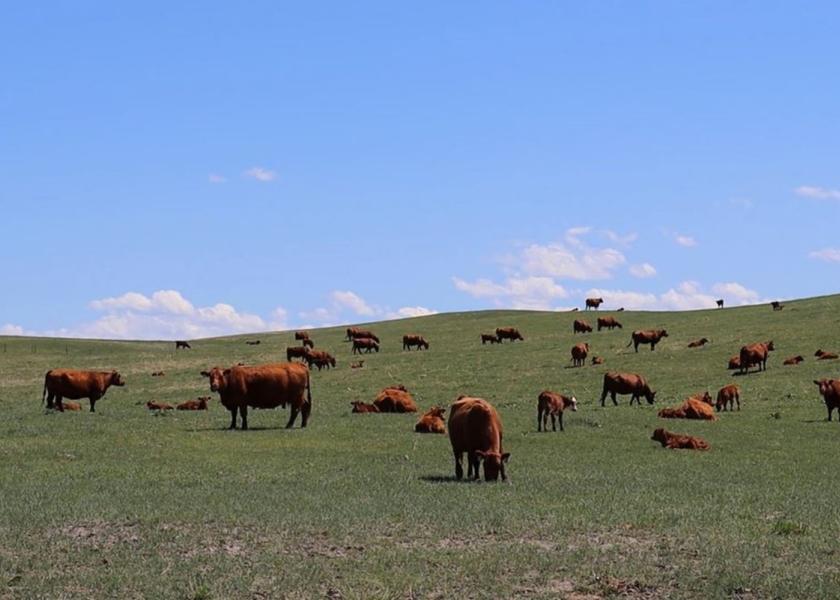Why Grazing Before Pastures are Ready Can Have Lasting Impacts

Key Points
- Winter precipitation was not enough to overcome the soil moisture deficit from three years of below normal precipitation for much of Nebraska.
- Grazing pastures early causes the plant to use nutrients stored in the roots to regrow which can cause a reduction of future growth.
- If delaying grazing is unavoidable, minimize impacts by moving through multiple pastures quickly.
Although near record snowfall this winter brought many challenges in areas of Nebraska, the moisture the snow provided was welcomed after three years of below normal precipitation. However, soil moisture is still below average and drought conditions are persisting in many areas of the state (Figures 1 and 2).
In the spring, plants rely on nutrients stored in the roots during previous years to initiate and sustain growth until enough leaf area is available to conduct photosynthesis. Without adequate growing season and fall moisture in previous years, nutrient storage is often limited. Not reducing grazing pressure during periods of below normal precipitation can compound this deficit and reduce production in subsequent years. Although fall and winter precipitation can recharge soil moisture levels, growing season precipitation (April to September) typically accounts for most of the total annual precipitation and is vital to plant production and rangeland health.
When feed is expensive and hard to find and feeder cattle futures are optimistic, delaying pasture turnout or destocking to reduce grazing pressure are not appealing. Especially if the available feed is low-quality and fails to meet a lactating cow’s nutrient requirements causing negative impacts to calf performance and delaying return to estrus and her ability to rebreed.
Unfortunately, not delaying turnout or destocking is robbing Peter to pay Paul by saving the cost of feeding hay at the expense of reducing pasture production and further degrading pastures. Grazing before pastures are ready causes the plants to use additional nutrients from already low root stores to recover. If there are not enough nutrients stored in the roots, the plant may go dormant and stop growing, reducing the total annual production. In contrast, allowing pastures additional rest to build nutrient storage by delaying turnout could pay dividends in additional growth later in the year.
When pastures will be ready to graze depends on plant condition and characteristics. Plant condition results from previous grazing seasons management as well as soil moisture and soil temperature which control the start and speed of plant growth. Cool season plants are the first to break dormancy and the first to reach maturity before the hot summer months. Warm season grasses wait for soil temperatures to get above 50 degrees Fahrenheit and continue to grow during the hot months until August.
Determining if a plant is ready to graze is as simple as counting leaves. The number of collared leaves that wrap all the way around the plant stem like a shirt collar indicates whether the plant is ready to be grazed. The rule of thumb is 3 collared leaves for cool season grasses and 4 collared leaves for warm season grasses. When grasses reach these minimums, enough photosynthesis occurs to sustain growth and allow storage of nutrients which can be used to recover from grazing. Not waiting for the minimum number of leaves stresses the plant at a critical time and may reduce total annual production potential.
If grazing before pastures are ready is unavoidable, the negative impacts can be spread lightly across multiple pastures by only grazing each pasture for a few days before moving. The key is to not stay too long and only lightly grazing the fresh growth. Grazing will stress the vulnerable plants, however impacts can be limited if the plant is not grazed repeatedly and sufficient recovery time is allowed before being grazed again. As always, avoid grazing a pasture at the same time of year multiple years in a row. As a last resort, a sacrifice pasture can be designated to limit damage to a single pasture, however the negative impacts may last for many years.
Another option is to lightly graze introduced pastures, hay fields, or subirrigated areas while allowing native pastures to reach leaf minimums. Be cautious not to reduce hay production later in the year by grazing these forages too short, not providing adequate rest following grazing, and if growing season precipitation is limited.
Resist the temptation to turn cattle out before grass is ready and use caution if there is no other option. Management practices now can have lasting impacts.








